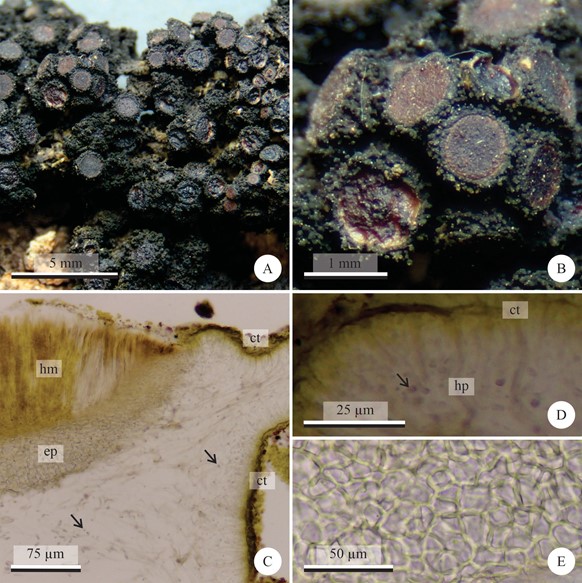Hondaria M.J. Kitaura & A.P. Lorenz, gen. nov.
MycoBank number: MB 835521; Index Fungorum number: IF 835521; Facesoffungi number: FoF;
Type species: Hondaria leptospora (Malme) M.J. Kitaura,M.C. Scur & A.P. Lorenz
Etymology: – The generic name is a tribute to Dr. Neli Kika Honda, who has dedicated her scientific career to study the chemistry of the lichens from Mato Grosso do Sul since 1992 (Oliva et al. 1992).
Thallus foliose, medium-sized (3–5 cm across), homoiomerous, black to dark olive brown when dry (Fig. 3A, B, C); lobes irregular in outline, irregularly branched, 1.5–3.0 mm wide, plane; lobe surface plane and with longitudinal ridges when dry, not swollen; cortex with amorphous layer without euparaplectenchymatous cells (Fig. 3D); isidia granular, laminal, marginal, and on the margin of apothecia, simple to grouped; tomentum not observed. Apothecia usually present, frequent, laminal, pedicellate, ornamented by isidia (Fig. 3B); disc plane to slightly concave, reddish brown; proper exciple euparaplectenchymatous (Degelius 1954, Fig. 3C and E). Asci 150–170 × 12.5–17.5 µm. Ascospores (100–)120–175(–200) × 2–4(–5) µm, acicular, straight to curved, transversally 5–8-septate. Pycnidia not observed.

Figure 3. Hondaria leptospora. A. Specimen JBP 04. B. Detail of the ornamented apothecia with granular isidia on the margin. C. Diametral section of an apothecium. D. Detail of amorphous cortex. E. Detail of euparaplectenchymatous tissue. (hm = hymenium, ep = proper exciple, ct = cortex, hp = hyphae, arrow = cyanobacteria).
Species
